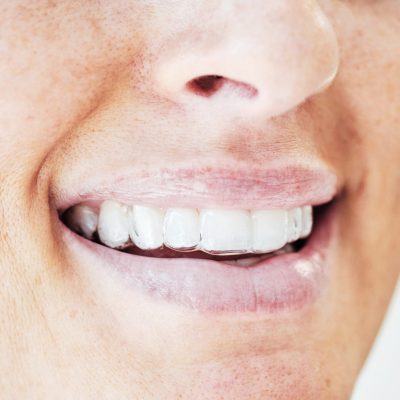Elegant and discreet
With the invisible braces from Invisalign, you have the opportunity to straighten your teeth in an elegant and discreet way. Invisalign can correct many different teeth alignment problems, but there are also cases where the invisible aligners are not suitable. In all cases, it will be based on an individual assessment as to whether Invisalign is a viable option for you.
At Clearli, we are dental specialists with years of experience in orthodontics with Invisalign. As a result, we know both the possibilities and the limitations of Invisalign. Our professional advice gives you the information you need to make a confident choice about the right treatment for you.

Challenges
We have put together an overview of the most common teeth alignment issues and the potential problems associated with them – if you can identify with any of these conditions, Invisalign might be for you.
Overbite
You have an overbite if the front teeth of your upper jaw are displaced in front of the front teeth of your lower jaw when you bite together. It is normal to have a minor overbite, but with a severe overbite, you may experience tooth wear and pain in the jaws.
Underbite
You have an underbite if the front teeth of your lower jaw are displaced in front of the front teeth of your upper jaw when you bite together. An underbite can make it hard to bite together and give difficulties with speech. In addition, there is a risk of increased wear on the teeth and stress on the jaw joints.
Deep bit
You have a deep bite if the front teeth of your upper jaw overlap the front teeth of your lower jaw vertically when you bite together. A bite that is too deep can cause damage and wear to teeth and gums due to increased contact between the upper teeth, lower teeth and gums.
Crossbite
You have a crossbite if your upper jaw is too narrow compared to your lower jaw. This means that the teeth in the side will be offset horizontally in relation to each other when you bite together. With crossbites, there is a risk of increased wear on the teeth as well as damage to the teeth. At the same time, parts of the gums may recede, causing pain in the gums.
Teeth with excessive spacing
You have widely spaced teeth if there is excessive spacing between two or more teeth in your jaw. Without adequate oral hygiene, large gaps between teeth can lead to the build-up of food debris and plaque around the teeth. This can lead to sore gums and eventually gum disease.
Open bite
You have an open bite if the front teeth of the upper jaw and the front teeth of the lower jaw are not in contact when you bite together. With an open bite, you may have trouble biting off certain foods, and you’re forced to bite using the sides.
Dental crowding
You have crowding if there isn’t enough space in your jaw for all your teeth to be there, causing misalignment of your teeth. In the case of crowding, it can be difficult to keep teeth clean of plaque, tartar and other bacteria. This increases the risk of caries and gum disease. In addition, crowding will often worsen over time.
Baby teeth and adult teeth
As a child grows, so do their jaws and their smiles. Therefore, between the ages 6 to 10, when the child still has milk teeth, this may be the optimal time for orthodontic treatment. This type of treatment is a preventive treatment (interceptive treatment), which can prevent the worsening of existing dental problems and reduce the extent of later orthodontic treatment.
